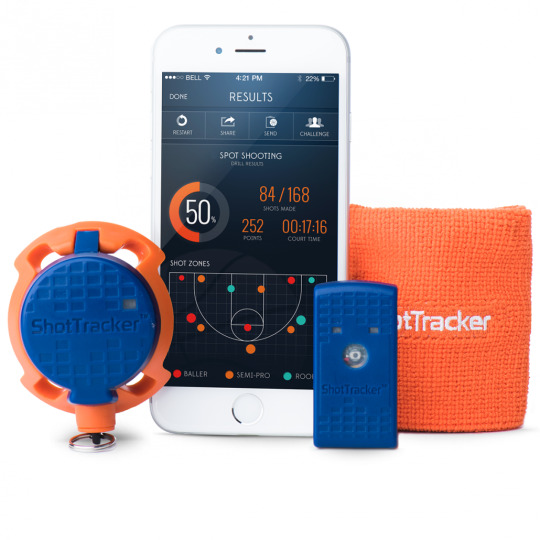
You can’t improve what you
don’t measure.
“Everybody
loves to shoot,” says Davyeon Ross,
co-founder and COO of ShotTracker, “and everybody wants to know
how well they did compared to the last time, and if they beat their friends. So
we’ve got all these components converging at the right time. This is what makes
ShotTracker special.”
A New Concept
ShotTracker is not only a new
product it’s a new concept: wearable
tech aimed at basketball players looking to improve their jump shot average.
Designed to automatically track shot attempts, makes and misses, ShotTracker
includes a wrist sensor, a net sensor, and the ShotTracker App that calculates and
compiles your shooting stats on a smartphone. When you shoot, the wrist sensor
signals the app that a shot has been attempted. The net sensor sends a signal to
the app indicating if the shot was made or missed. The app does the
bookkeeping.
Ross, co-founder of
ShotTracker along with his pal Bruce Ianni (and a great start-up team) makes it
sound easy but a great player makes a perfect jump shot look easy too. Neither a
jump shot nor a business startup is easy.

Ross
started playing basketball in Trinidad and Tobago, a twin-island Caribbean
state just off the coast of Venezuela. He won a collegiate basketball
scholarship to Benedictine College, a liberal arts school
in Atchison, Kansas, where he earned a B.S. in Computer
Science. He went on to slam-dunk an M.B.A. at Mid-America Nazarene.
Ianni played competitive basketball through high school, and continued
his athletic career at John Carroll University where he was a three-year
letterman and defensive back for the football team. He majored in chemistry, and
holds a B.S. in Business Administration as well.
Both Ross and Ianni started successful tech
businesses—and ended up selling them for impressive profits. So by 2008-2009,
when they met through
the Pipeline, a Kansas technology fellowship, they had business experience
and a bit of a financial war chest. The two basketball players hit it off
immediately.
500 to 1000 Jumpers a Day
“The
idea came from my co-founder,” says Ross. “He was shootin’ jumpers in
the backyard with his son, and being an analytics guy with a tech company he
was thinking, ‘Man, there’s got to be a way for us to do this.’ He knew I had a
computer science background, and he knew I played basketball, so he called me
up and immediately I was finishing his sentences. I used to shoot 500 to 1000
jumpers a day. Later, in my senior year, I led the nation in field goal
percentage, so it was one of those things where it just resonated with
me.”
It
was such a good idea that Ross was surprised somebody hadn’t already brought
shot tracking technology to market, so he started looking into whether they
could accomplish it technically. Finally he called Ianni and said, “Look,
man, this opportunity is wide open. We should really do this.”
Initial
funding wasn’t a problem. This was the second time around for both founders,
and people knew who they were. When you have two entrepreneurs who exited their
previous companies with enough discretionary income to practically fund a start-up
by themselves, it makes raising additional funding a lot easier. And when you
put as much of your own money into a company as Ross and Ianni did, that buys
you credibility with investors. “We had people who had invested in our
earlier companies,” Ross recalls, “who had bet on us and had some
success, and they were OK with betting on us again.”
It
didn’t hurt that the idea was sexy, given the convergence of wearable
technology and analytics. Ross and Ianni had a good recipe for raising capital
As
it turns out, the biggest challenge wasn’t funding, it was getting the thing to
work.
I Can’t Tell You ‘Don’t
Dribble’
“We
were trying all kinds of stuff,” laughs Ross. “It’s not easy to
identify when somebody shoots. I can’t tell you, ‘Don’t dribble, because it may
set off a false positive.’ I can’t tell you, ‘Don’t pass.’ I can’t tell you, ‘Just
catch and shoot.’ I have to allow you to do what’s natural and organic in the
game of basketball.”
Fortunately,
the ShotTracker R&D facility included a basketball court. At one point the
tech team scrapped the circuit board they were testing and just strapped
iPhones to their wrists, because they had built the application using raw data
from the iPhone. Now they needed to figure out what chip was in there and what
it was doing, because the phone was working a lot better than the board they
had built.
“We
were actually shooting with the iPhones strapped on, trying to figure out the
right data, the right algorithms to make this happen,” says Ross. “I
remember one Sunday night our firmware engineer and director of engineering had
been working all weekend in the shooting lab, and they thought, ‘We got it!’ They
reached out to Bruce and me and we all came into the office and started to
test. It was 3 am before we left the office. We couldn’t break it! That was our
big breakthrough point.”
Getting the Word Out
If
making it work was the hardest part, marketing a unique product like
ShotTracker is no cakewalk either. Ross, Ianni and their team use email
marketing quite a bit, especially to target coaches with a Coaches App that
allows them to send workouts to their players and track their progress in real
time. And social media, of course. “Our audience is big on Instagram,”
says Ross, “big on social. Twitter has been decent for us from a
conversion perspective too.”
But
the biggest score in ShotTracker’s marketing game was inking a partnership with
Klay Thompson, the star shooting guard of the NBA Champion Golden State
Warriors, and his Virtual Basketball
Camp. “It got to the point where all together people were shooting 30,000
– 40,000 jump shots a day as part of the virtual camp,” Ross declares.
“The engagement level the camp drove was exceptional. Having a partner
like Klay is incredible.”

Down to Repetition
Perhaps
you’re wondering how ShotTracker, which simply records makes and misses,
improves your game.
“When
it comes to basketball and shooting,” Ross explains, “it comes down
to repetition. If you look at the NBA, there are about 450 players and they all
have a unique jump shot. So what that tells you is that it’s about getting that
10,000 shots in, workin’ on your craft. There are some mechanics that go into a
better shot, whether it’s the degree of your arc or squaring up your body—but
when it comes to getting your game to the next level it’s about repetition and
puttin’ in the work. You won’t see a businessman talking about his sales
forecast without tracking how he did the week before. The same goes for
sports—specifically shooting in basketball. That’s where ShotTracker kicks
in.”




